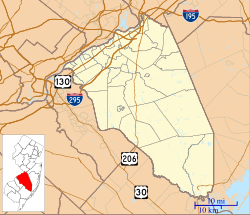Bordentown School
|
New Jersey Manual Training and Industrial School for Colored Youth
|
|
 |
|
| Location | N of Burlington Rd., W of I-295, Bordentown, New Jersey |
|---|---|
| Coordinates | 40°8′29″N 74°43′25″W / 40.14139°N 74.72361°WCoordinates: 40°8′29″N 74°43′25″W / 40.14139°N 74.72361°W |
| Area | 97 acres (39 ha) |
| Built | 1903 |
| Architect | Guilbert and Betelle; Lowrie, Charles N. |
| Architectural style | Colonial Revival |
| NRHP Reference # | 97001563 |
| Added to NRHP | January 05, 1998 |
The Bordentown School (officially titled the Manual Training and Industrial School for Colored Youth, the State of New Jersey Manual Training School and Manual Training and Industrial School for Youth, though other names were used over the years), was a residential high school for African-American students, located in Bordentown in Burlington County, New Jersey, United States. Operated for most of the time as a publicly financed co-ed boarding school for African-American children, it was known as the "Tuskegee of the North" for its adoption of many of the educational practices first developed at the Tuskegee Institute in Alabama. The school closed down in 1955.
The school was founded in 1886 in the New Brunswick house of the Rev. Walter A. Rice, a minister of the African Methodist Episcopal Church and former slave from Laurens, South Carolina. Born in 1845, Rice had fought as a volunteer with the Union Army during the American Civil War and went to New Jersey to get an education, after completing his military service. When it was first founded, it was known as "The Ironsides Normal School". The school's mission was to train African-American students "in such industries as shall enable them to become self-supporting". The state passed legislation in 1894 to designate the school as the state's instructional institution for vocational education. With this legislation, the school was placed under the aegis of a board of trustees composed of state and county officials. The school came under the direct auspices of the New Jersey Board of Education in 1903, with its capital expenditures, curriculum and staffing under state approval. In 1886, the school moved to Bordentown and moved in 1896 to a 400-acre (1.6 km2) tract there that had been owned by United States Navy Admiral Charles Stewart and known as the Parnell Estate. The state originally leased the land, and purchased it in 1901.
...
Wikipedia



